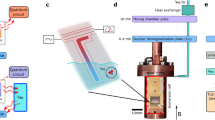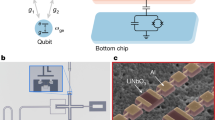Abstract
Arguments first proposed over thirty years ago, based on fundamental quantum-mechanical principles, led to the prediction1,2,3 that if macroscopic quantum systems are weakly coupled together, particle currents should oscillate between the two systems. The conditions for these quantum oscillations to occur are that the two systems must both have a well defined quantum phase, φ, and a different average energy per particle, μ: the term ‘weakly coupled’ means that the wavefunctions describing the systems must overlap slightly. The frequency of the resulting oscillations is then given by f = (μ2− μ1)/h, where h is Planck's constant. To date, the only observed example of this phenomenon is the oscillation of electric current between two superconductors coupled by a Josephson tunnelling weak link4. Here we report the observation of oscillating mass currents between two reservoirs of superfluid 3He, the weak link being provided by an array of submicrometre apertures in a membrane separating the reservoirs. An applied pressure difference creates mass-current oscillations, which are detected as sound in a nearby microphone. The sound frequency (typically 6,000–200 Hz) is precisely proportional to the applied pressure difference, in accordance with the above equation. Thesesuperfluid quantum oscillations were first detected while monitoring an amplified microphone signal with the human ear.
This is a preview of subscription content, access via your institution
Access options
Subscribe to this journal
Receive 51 print issues and online access
$199.00 per year
only $3.90 per issue
Buy this article
- Purchase on Springer Link
- Instant access to full article PDF
Prices may be subject to local taxes which are calculated during checkout


Similar content being viewed by others
References
Josephson, B. D. Possible new effects in superconductive tunneling. Thesis, Cambridge Univ.((1962)).
Anderson, P. W. in Lectures on the Many-Body Problem (ed. Caianello, E. R.) 113–135 (Academic, New York, (1964)).
Feynman, R. P. The Feynman Lectures on Physics Sect. 21-9 (Addison Wesley, New York, (1965)).
Josephson, B. D. Possible new effects in superconductive tunnelling. Phys. Lett. 1, 251–253 (1962).
Reif, F. Fundamentals of Statistical and Thermal Physics Sect. 8-7 (McGraw-Hill, New York, (1965)).
Tilley, D. R. & Tilley, J. Superfluidity and Superconductivity (Hilger, New York, (1990)).
Vollhardt, D. & Woolfle, P. The Superfluid Phases of Helium-3 Sect. 7-2 (Taylor & Francis, New York, (1990)).
Tilley, D. R. & Tilley, J. Superfluidity and Superconductivity Sect. 7-6 (Hilger, New York, (1990)).
Pereverzev, S. V. Toward the Josephson effect in superfluid helium: how to make 20 nm holes in a 10 nm thick membrane. J. Low Temp. Phys. 101, 573–579 (1995).
Amar, A., Sasaki, Y., Lozes, R. L., Davis, J. C. & Packard, R. E. Fabrication of submicron apertures in thin membranes of silicon nitride. J. Vac. Sci. Technol. B 11, 259–262 (1993).
Paik, H. J. Superconducting tunable-diaphragm transducer for sensitive acceleration measurements J. Appl. Phys. 47, 1168–1178 (1976).
Avenel, O. & Varoquaux, E. in Proc. 10th Int. Cryogenic Eng. Conf. (eds Klipping, G. & Klipping, I.) 587–589 (Butterworths, Guildford, (1986)).
Monien, H. & Tewordt, L. Theory of Josephson flow oscillations in superfluid 3He-B. J. Low Temp. Phys. 62, 277–300 (1986).
Hook, J. R. Current-phase relation for flow of an s-wave paired superfluid through a cylindrical channel of finite length. Jpn. J. Appl. Phys. 26, 159–160 (1987).
Kurkijärvi, J. Josephson current through a short and narrow orifice in a p-wave superfluid. Phys. Rev. B 38, 11184–11187 (1988).
Thuneberg, E. V. Two dimensional simulation of the Josephson Effect in superfluid 3He. Europhys. Lett. 7, 441–446 (1988).
Ullah, S. & Fetter, A. L. Superfluid 3He-B in a weak link. Phys. Rev. B 39, 4186–4190 (1989).
Thuneberg, E. V., Kurkijärvi, J. & Sauls, J. A. Quasiclassical theory of the Josephson effect in superfluid 3He. Physica B 165&166, 755–756 (1990).
Avenel, O. & Varoquaux, E. Josephson effect and quantum phase slippage in superfluids. Phys. Rev. Lett. 60, 416–419 (1988).
Varoquaux, E., Avenel, O., Ihas, G. & Salmelin, R. Phase slippage in superfluid 3He-B. Physica B 178, 309–316 (1990).
Steinhauer, J. The current-pressure relation for a superfluid 3He weak link. Thesis, Univ. California, Berkeley((1995)).
Mukharsky, Yu. M., Loshak, A., Schwab, K., Davis, J. C. & Packard, R. E. Study of an array of superfluid 3He weak links. Czech. J. Phys. 46, 115–116 (1996).
Shapiro, S. Josephson currents in superconducting tunnelling; the effect of microwaves and other observations. Phys. Rev. Lett. 11, 80–82 (1963).
Packard, R. E. & Vitale, S. Principles of superfluid-helium gyroscopes. Phys. Rev. B 46, 3540–3549 (1992).
Acknowledgements
In early stages of this work we were helped by J. Steinhauer, K. Schwab, Yu. M. Murkarsky and I. Schuster. E. W. Hudson made important contributions to the data acquisition system. Figure 1b was made by R. Orr. The aperture array was constructed at the Berkeley Microfabrication Laboratory. This work was supported in part by the National Science Foundation, the Office of Naval Research, and the Packard Foundation.
Author information
Authors and Affiliations
Author notes
Correspondence and requests for materials should be addressed to R.E.P.
Corresponding author
Supplementary information
Supplementary Information
Supplementary material for the article (WAV 712 kb)
Rights and permissions
About this article
Cite this article
Pereverzev, S., Loshak, A., Backhaus, S. et al. Quantum oscillations between two weakly coupled reservoirs of superfluid 3He. Nature 388, 449–451 (1997). https://doi.org/10.1038/41277
Received:
Accepted:
Issue Date:
DOI: https://doi.org/10.1038/41277
This article is cited by
-
Periodic squeezing in a polariton Josephson junction
Nature Communications (2017)
-
Polaritonic Rabi and Josephson Oscillations
Scientific Reports (2016)
-
Polariton condensation in solitonic gap states in a one-dimensional periodic potential
Nature Communications (2013)
-
Order-related acoustic characterization of production data
Logistics Research (2012)
-
Generalized Rotational Susceptibility Studies of Solid 4He
Journal of Low Temperature Physics (2012)
Comments
By submitting a comment you agree to abide by our Terms and Community Guidelines. If you find something abusive or that does not comply with our terms or guidelines please flag it as inappropriate.



